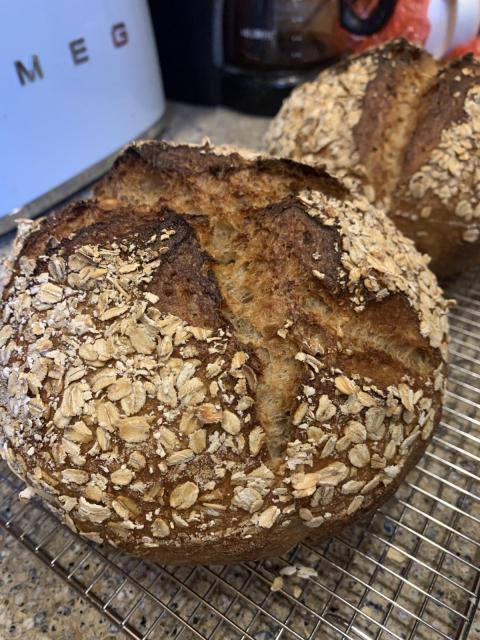
Cracked the code on Tartine 3 Oat Porridge Bread

I have to give a shout-out to Maurizio, because his 2014 oat porridge bread entry had loads of tips that inspired me. Here are the main changes I made to the original Tartine 3 recipe:
- Reduced the hydration by 50g
- Increased the whole grains by using Type 110 high-extraction flour and Turkey Red whole wheat (no white bread flour)
- Added diastatic malt to help with oven spring
- and added the porridge at the post-autolyse mixing stage instead of at the first fold.
Details:
Levain
18g starter
70g Type 110 flour (Central Milling organic Type 110)
70g warm water
Porridge:
250g rolled oats (Bob’s Red Mill)
500g water
Final dough:
158g Levain from above
800g Type 110 high-extraction flour
200g Turkey Red whole wheat flour (Janie’s Mill)
700g water, divided
25g fine sea salt
5g diastatic malt
Method:
Levain
5 hours at 78 degrees in Brod & Taylor proofing box, until light and bubbly
Porridge
Rather than cooking it, I just poured boiling water onto the rolled oats and soaked them for 2 hours.
Autolyse
Mixed 625g water and levain until dissolved. Added flour and malt, mixed until there was no white visible. Rested covered, 1 hour.
Mixing
Mixed the oats with 50g water (to make it easier to mix into the dough), then added to autolyse mixture with the salt. Pinched and folded for 5 minutes, but seemed dry, so added another 25g water. Used the rubaud method for 10 minutes to further mix and build strength.
Bulk fermentation
3 hours in Brod & Taylor proofing box (first set at 78, then turned down to 72 after an hour)
5 stretch & folds, at 30-minute intervals (the later stretches were gentle, as the dough was tight)
Shaping, proofing and baking
Divided, preshaped, rested 20 minutes.
Shaped into tight boules, then picked up and inverted, coating the bottom in uncooked rolled oats before placing in 8” bannetons.
Proofed for 12 hours in 39-degree fridge.
Inverted onto a parchment-lined plate and lifted into Emile Henry bread pots heated in 500 degree oven.
Scored and baked covered at 500 for 20 minutes, at 450 for 10 minutes, then uncovered for 28 minutes.
Note: The dough sticks to the bannetons a LOT. As you invert the banneton, you have to reach your fingers in and loosen the edges until it releases onto the plate.



Comments
Chelsea, really beautiful baking you’ve done there, thanks for sharing the details of your formula.
Benny
" Inverted onto a parchment-lined plate and lifted into bread pans heated in 500 degree oven. Scored and baked in Emile Henry bread/potato pot, ..."
I'm confused what the bread pans are doing between the plate and the EH pot.
Hmm let me try to clarify. The dough is in a banneton. I put parchment paper on a plate and put it on top of the banneton, and turn it over and remove the banneton. I then lift the paper with the dough and lower it into the hot dutch oven. Does that make sense?
I thought the "bread pan" was something other than the EH pot/dutchoven.
In the US, or at least to me, a "bread pan" is a rectangular thin-walled metal pan.
They look great.
The profile of your “basketball” loaf is interesting. Normally the bottom of the loaf is flat. How do you account for the round bottom?
Danny, the round bottom is from my Emile Henry bread/potato pot. All the loaves come out like that. Overall the size of this pot really seems to help with oven spring by constraining the dough.
It's this one, if anyone's interested: https://shop.kingarthurbaking.com/items/bread-and-potato-pot-red?gclid=EAIaIQobChMIy8KBzIqy7QIVlYpaBR0CgQN3EAAYASAAEgL3XfD_BwE
Thanks, I like the rounded profile. I have gotten that affect using a Lekue . The breads bakes up like a football.
That is some delish looking porage bread!
I noticed in the book, the porridge used was 500g, but here you used 750g. Did you find better results using more oats?